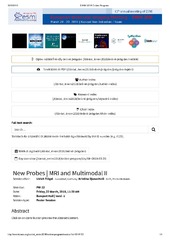Приказ основних података о документу
Biocompatible Materials labelled with Microenvironment Responsive MRI Probes for the follow-up of Cell Transplants
| dc.creator | Capuana, Federico | |
| dc.creator | Padovan, Sergio | |
| dc.creator | Grange, Cristina | |
| dc.creator | Catanzaro, Valeria | |
| dc.creator | Cutrin, J. C. | |
| dc.creator | Stevanović, Magdalena | |
| dc.creator | Filipović, Nenad | |
| dc.creator | Digilio, G. | |
| dc.date.accessioned | 2018-12-23T07:48:34Z | |
| dc.date.available | 2018-12-23T07:48:34Z | |
| dc.date.issued | 2018 | |
| dc.identifier.uri | http://eventclass.org/contxt_emim2018/online-program/session?s=101#153 | |
| dc.identifier.uri | https://dais.sanu.ac.rs/123456789/4667 | |
| dc.description.abstract | Introduction: Cell encapsulation by hydrogels is intended to shield transplanted cells from the host hostile environment by preventing the infiltration of host immune cells. Cell scaffolding by solid biocompatible microparticles is intended to provide a structural support to implanted cells and to mimic the extracellular matrix, allowing cells to proliferate and/or differentiate in the desired way. We present strategies to label scaffolding biomaterials with microenvironment responsive MRI probes, for applications in the follow-up of cell transplants. Methods: Microparticles (MPs) based on PLGA/chitosan were incorporated with gadolinium fluoride nanoparticles (GdNPs), as the MRI T1-contrast agent. The system is designed such to release Gd-NPs in the extracellular matrix (ECM), thus activating MRI contrast, unless MPs are attacked by the immune system (Foreign Body Response, FBR). To proof the concept, PLGA-based MPs were seeded with hMSCs and implanted into either immunocompetent or immunocompromised mice, and the transplants were followed-up by MRI for three weeks. Ex-vivo histologic assessment was carried out at the end of the follow-up. Results/Discussion: Immunocompetent mice showed poor activation, if any, of MRI contrast within the cell graft. Immunocompromised mice, on the other hand, showed a progressive activation of MRI contrast. Ex-vivo histology showed extensive FBR directed against microparticles in immunocompetent mice, with some surviving hMSCs in the ECM but not on the scaffold surface. No significant FBR was detected in immunocompromised mice, and hMSCs were still adhering to the scaffolds. Conclusions: The proposed system is able to assess whether or not cell grafts are subjected to innate immune response, an event that is likely correlated to the loss of transplanted cells. | en |
| dc.language.iso | en | sr |
| dc.publisher | European Society for Molecular Imaging | sr |
| dc.relation | Italian Ministry of Foreign Affairs and International Cooperation (MAECI) within the collaboration framework between Italy and the Republic of Serbia (project PGR02952, call “Grande Rilevanza”) | sr |
| dc.rights | openAccess | sr |
| dc.rights.uri | https://creativecommons.org/licenses/by-nc-nd/4.0/ | |
| dc.source | European Molecular Imaging Meeting - EMIM 2018, March 20-23, Kursaal San Sebastian, Spain : Online Program | sr |
| dc.subject | PLGA/chitosan | sr |
| dc.subject | gadolinium fluoride | sr |
| dc.subject | MRI contrast agents | sr |
| dc.subject | cell encapsulation | sr |
| dc.title | Biocompatible Materials labelled with Microenvironment Responsive MRI Probes for the follow-up of Cell Transplants | en |
| dc.type | conferenceObject | sr |
| dc.rights.license | BY-NC-ND | sr |
| dcterms.abstract | Филиповић, Ненад; Стевановић, Магдалена; Цапуана, Ф.; Падован, С.; Гранге, Ц.; Цатанзаро, В.; Цутрин, Ј. Ц.; Дигилио, Г.; | |
| dc.type.version | publishedVersion | sr |
| dc.identifier.fulltext | https://dais.sanu.ac.rs/bitstream/id/14590/EMIM-2018-153.pdf | |
| dc.identifier.rcub | https://hdl.handle.net/21.15107/rcub_dais_4667 |

